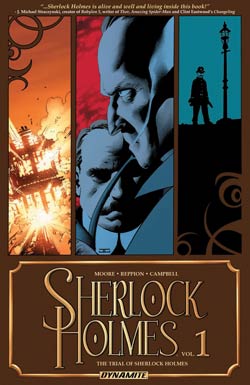
One of my favorite aspects about the film was the inclusion of mystery along with the action. Mystery is, I think, an aspect of “crime fiction” that is often left out in a lot of modern stories. Mystery fiction showcases a detective of some sort, trying to unravel a puzzle, and bring the culprit to justice. More generally, crime fiction showcases lowlifes or ordinary people caught up in events beyond their control. There’s not a lot of wonderment in say, a heist tale, other than how the robbers pull off the steal. It seems, also, that there’s usually a lot of action in crime fiction where mystery fiction can (but not always) trend towards the mental.
Sir Arthur Conan Doyle knew that both ingredients—mystery and crime with a little action thrown in—made for a good story. Why else did he name the first dozen Holmes tales “Adventures”? It’s a lesson continued by his literary descendants, Leah Moore and John Mark Reppion, who have scripted The Trial of Sherlock Holmes, a comic book series for Dynamite Comics. This gripping story, a more traditional portrayal for all the purists out there, could have emerged directly out of Doyle’s pen.
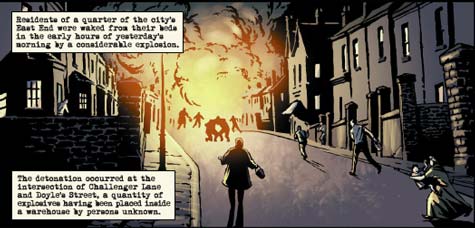
According to a letter Holmes has received, the explosion is not some random act. Sir Samuel Henry, former assistant police commissioner, writes to Holmes that he, Henry, is to be murdered at his house precisely at 7pm the next day. If Henry makes plans not to be at his house at the appointed hour, additional explosions will tear London apart. Naturally, Holmes and Watson, together with Inspector Lestrade and a cadre of London’s finest, all guard Henry and his estate. While waiting, Lestrade informs Holmes of another, separate, typed letter. It seems some loyal Britons don’t want the Germanic Baron Lothair to set foot upon English soil, something the nobleman is about to do on a tour of 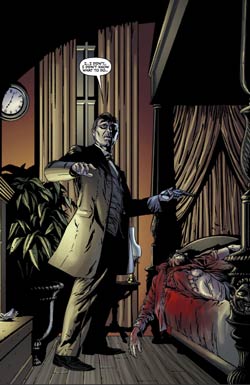
As the gentlemen are discussing these developments, Sir Henry’s many clocks chime a quarter until seven. A few minutes later, a request is delivered by one of the policemen: Sir Henry wishes Holmes to come into his bedroom, alone. This Holmes does. At precisely seven o’clock, a single shot rings out. Lestrade, Watson, Detective Inspector Davis (of Special Branch), and all the policemen race upstairs. Seeing the door to Sir Henry’s bedroom locked from the inside, they break it down. What they find astonishes them: Holmes, standing over the dead body of Sir Henry, a smoking revolver in his hand, his face containing a look of utter surprise.
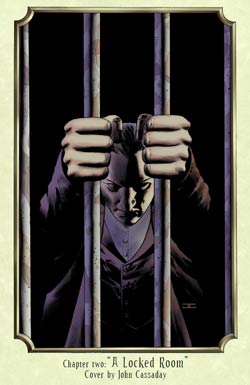
One of the joys of reading a so-called “fair play” mystery is that the author gives readers all the information the detective has, and readers can see whether the correct solution presents itself to them before the denouement. In movies, it’s pretty easy to achieve. Let the camera linger on something or have an off-screen sound give the viewers a clue. Books present a bit of a different problem in that the author has to make sure the detective asks the right questions. Comic books, you might think, would be easy. It’s a visual medium, like movies, but you also have the printed words. Moore and Reppion provide the clues necessary to make some educated guesses, but you have to be an astute comic reader to see and read them. Upon a second reading, much like re-watching The Sixth Sense, once you know the secret, you see all the clues were there. Brilliant.
I was happily surprised at the relationship between Watson and Lestrade. If you’ve read the Doyle stories, you know Holmes has all but disdain for the metropolitan police, Lestrade being one only slightly more capable than the rest. Here, Lestrade holds his own and shows himself to be as loyal to Holmes as Watson. Even Sherlock’s brother, Mycroft, makes an appearance.
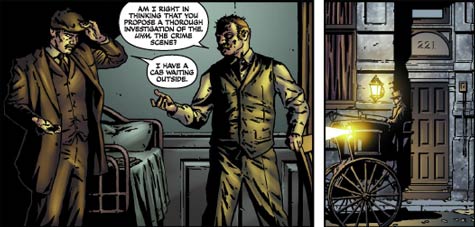
The Trial of Sherlock Holmes, available in hardcover, comes with some great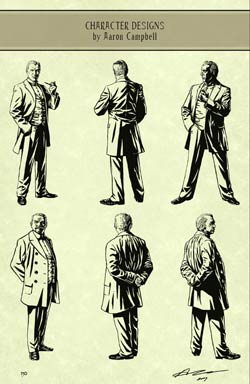
Holmes pastiches are often fun, and provide authors other than Conan Doyle a chance to play with Holmes and Watson. Rest assured, The Trial of Sherlock Holmes can stand with the best of them. After reading this story, I had only one thought: when is the sequel?
Scott D. Parker is a professional writer who discusses books, music, and history on his own blog, and is a regular columnist for Do Some Damage.

Scott, thanks for such a great write up, mate. We’re thrilled you enjoyed the series so much.
When’s the sequel? Sherlcok Holmes – The Liverpool Demon is coming soon! 😉
When you like something, you want to tell everyone else how much fun you had reading it. And this was classic.
I went out and checked y’all’s website (
http://www.moorereppion.com/
) but didn’t see a release date. Is it a secret, or can you spill a few tidbits?
No secret – just waiting (and hoping) for Aaron to have some free time to draw it. He’s a busy guy these days.
Thanks again.
best
John
At last, our follow up to The Trial is coming in December:[quote]Sherlock Holmes is busy doing what he does best, solving a case of far-reaching international notoriety. It has landed him at the Port of Liverpool, a bustling hub of commerce both legitimate and illicit. As that chapter closes, ours begins. They head to Lime Street Station, to catch a fast steam locomotive home to London and Baker Street, when violent weather keeps The Great Detective and Watson in Britain’s second city a while longer. Long enough to encounter a monster, discover the Liverpool underworld, and to become embroiled in one of his strangest cases yet.[/quote]More info at
[url=http://www.dynamite.net/htmlfiles/viewProduct.html?CAT=DF-Sherlock_Holmes_The_Liverpool_Demon]http://www.dynamite.net/htmlfiles/viewProduct.html?CAT=DF-Sherlock_Holmes_The_Liverpool_Demon[/url]
Hope you’ll check it out! 😉